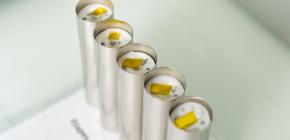Ask for a reprint
email :
* Give your email
2021
ACL
|
Q.Wang, S.Mariyappan, G.Rousse, A.V.Morozov, B.Porcheron, A.Iadecola, R.Dedryvère, J.Wu, W.Yang, L.Zhang, M.Chakir, M.Deschamps, M.L.Doublet, A.M.Abakumov, J.M.Tarascon, 'Unlocking anionic redox activity in O3-type sodium 3d layered oxides via Li substitution', Nat. Mater. 20 353–361 (2021) doi:10.1038/s41563-020-00870-8
Sodium ion batteries, because of their sustainability attributes, could be an attractive alternative to Li-ion technology for specific applications. However, it remains challenging to design high energy density and moisture stable Na-based positive electrodes by implementing the anionic redox process that has recently boosted the capacity of Li-rich layered oxides. Here, we report the first anionic-redox active O3-NaLi1/3Mn2/3O2 phase obtained through a ceramic process by carefully controlling the delicate balance between synthesis conditions and stoichiometry. It shows a sustained reversible capacity of 190 mAh/g by redox processes on oxygen ions as deduced by combined HAXPES and mRIXS spectroscopy techniques. Remarkably, unlike any other anionic-redox layered oxides so far reported, O3-NaLi1/3Mn2/3O2 electrodes do not show voltage fade upon cycling. This finding is due to switching from the interlayer to intralayer migration of the Mn cations promoted by Li+ displacement towards the alkali layer upon first Na+ deinsertion. Another practical asset of this material stems from its moisture stability, hence facilitating its handling and electrode processing. Besides providing insightful fundamental findings pertaining to anion redox, this work offers future directions towards designing high energy density electrodes for advanced Na-ion batteries.
|

|